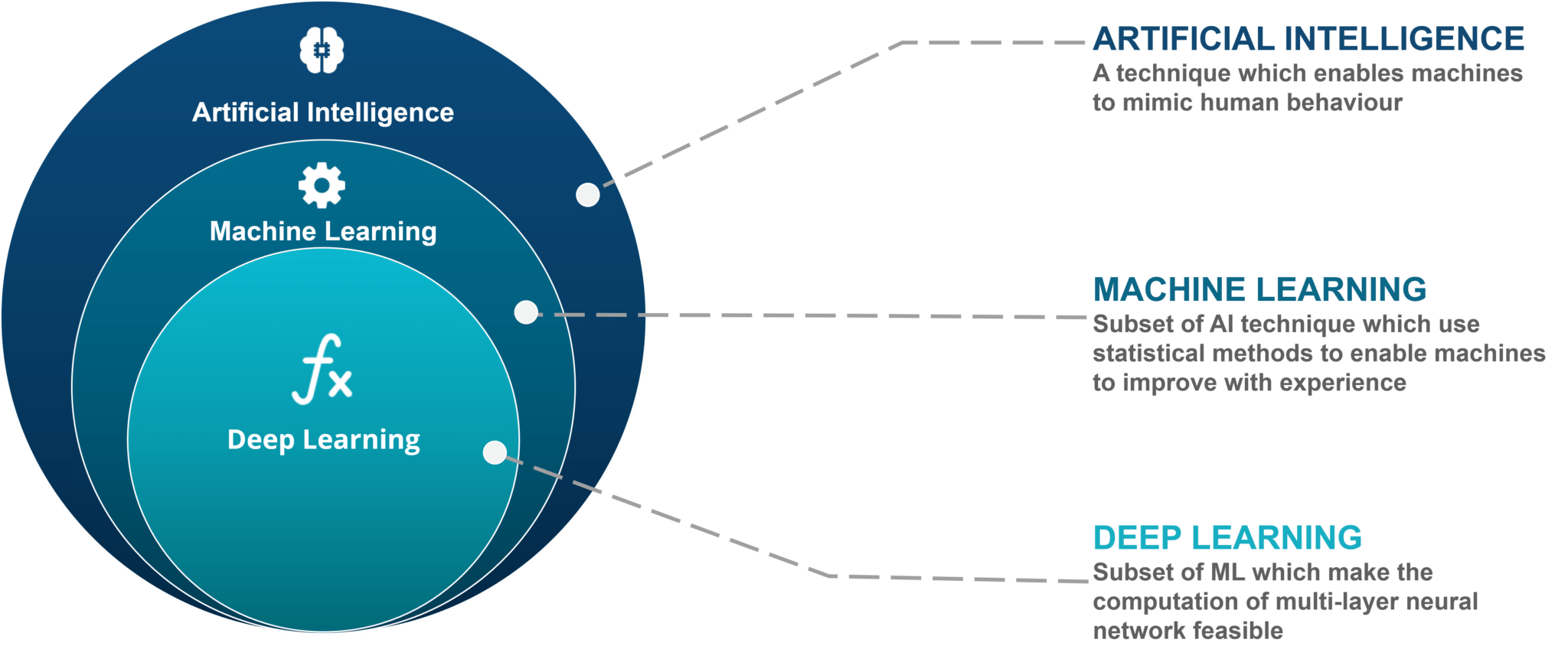But what is artificial intelligence? Broadly speaking AI is made up of three pillars:
Natural language processing, machine learning, and neural networks.
Today, we’re going to tackle the one that’s the most common right now — machine learning — and cover what it is, how businesses can use it, and some different platforms that offer machine learning in the cloud.
What is Machine Learning?
Machine learning is, at its quintessence, a simple concept. Computers are built on algorithms. Algorithms are sets of rules that govern specific behaviour. For example, you might write an algorithm for a robot that says: “When your camera detects an image 15cm in front of you, stop.”
Algorithms form the basis of almost every computing. They can get incredibly complex, but ultimately boil down to “if X situation transpires, do Y behaviour.”
Machine learning is when machines can take an algorithm (sometimes called “rules-based programming”) and improve it and “learn” over time as they interact with more data.
If we go back to our example of the robot, imagine that robot software was in a self-driving car. Stopping if it detects a child is great. But what if it’s just a leaf? Does it still need to stop?
With machine learning, you can feed a computer with terabytes and petabytes of data, so they learn the difference, and write their own algorithms based on the underlying human-driven programming to achieve the desired result.
As Nvidia put it:
“Machine Learning at its most basic is the practice of using algorithms to parse data, learn from it, and then make a determination or prediction about something in the world.”

Image Source: Tech-E
How do Businesses Use Machine Learning?
Business applications of AI and machine learning have only really emerged over that 2-3 years because:
- Big data was too noisy and disorganized to be used to train a computer
- There wasn’t enough computing power to make machine learning practical (remember, computers have to be trained by exposing them to huge amounts of data. That’s hungry work for a CPU).
Now though, machine learning (ML, for short) is used in all sorts of business applications.
eCommerce applications
eCommerce brands have started using machine learning to delve deeper into their data to find and target their most high-value customers. For example:
- CLV modelling: using ML to look at total customer value and learn the early indicators that suggest someone’s a high lifetime value spender (retention/churn modelling is basically the opposite, using ML to identify and mitigate low spenders and leavers).
- Dynamic pricing: Relying on behaviour indicators as well as external factors to raise or lower the price in real time, rather than fixing it over time.
- Recommendation engines: Recommending relevant products and add-ons to the right person has been used forever (e.g. putting the flour next to the sugar in the supermarket). But ML has allowed this to be taken to a whole new level. Amazon and Netflix are two organizations in particular who have benefited enormously.
Image recognition
If ML is all about pattern recognition that improves over time, it makes sense that image recognition is a key avenue for businesses to explore. ML is being used to train computers to read medical scans, tag the right face on Instagram, or recognize specific products from pictures.
Smarter hiring
Hiring is always difficult. However now, ML is allowing businesses to screen resumes and cover letters to identify top performers from bottom ones to make hiring better for companies and better for employees.
Key Providers
So how is all this happening? Cloud platforms. Google, Microsoft, Amazon, and IBM, all have machine learning platforms for companies to leverage.
Google DeepMind platform
Getting plenty of positive press for building an AI that could be a human at the board game Go, DeepMind is a frontrunner in the AI space despite Google’s lack of market share in cloud computing. Currently, the platform is primarily focused on using machine learning for research and in their own tools, but there are other applications as well.
Two worth mentioning are WaveNet, a neural network program that makes AI speech sound more human, and Stream, an app for the NHS that keeps doctors and medical teams up to date on customer status.
Right now, DeepMind isn’t a platform that other organizations can leverage effectively, being tied up with Google’s projects.
Microsoft Azure AI platform
Microsoft’s Azure AI platform uses machine learning primarily to analyze images and making predictions using data.
Azure is built to offer edge computing functionality so that insights and data-driven decisions can be made more easily. It focuses heavily on simple deployments that let developers run experiments on which algorithms to use so that they can deliver results quickly. They underscore this offering with a robust analytics tool so you can understand results rapidly and efficiently.
All of this functionality is built to pull data from Microsoft’s own suite, Azure servers, and SAP’s ERP. However, they stress that their python environment-agnostic.

Source: Azure AI
IBM Watson platform
Watson is probably the most advanced in terms of business offerings of the main AI platforms. According to the Watson's website, it’s an “open, multi-cloud platform that lets you automate the AI lifecycle.”
More than other providers, IBM focuses on providing a suite of AI tools that organizations can pick and choose when and where they apply them. Machine learning is one such module. For IBM, it focuses on predictive insights for businesses.
One thing that’s especially valuable about Watson is that it can work with both structured and unstructured data, making it far easier to find a data lake large enough to create a meaningful training program. Combined with auto-generating APIs and plenty of model and optimization templates, IBM can expect to see their investment pay off by making AI a bit more achievable for all sorts of businesses.
Amazon AI platform
Of course, where would we be without Amazon and AWS? Naturally, Bezos isn’t sitting on his laurels, and Amazon has an AI play to make.
Their goal, much like IBM, is to get AI and machine learning into the hands of developers quickly and efficiently.
Like IBM, they offer ML that’s quick and easy to use, with:
- A focus on servicing data scientists with tools designed specifically to help analyzed data effectively.
- AI services to help solve common ML problems (recommendations, forecasting, image analysis, etc…)
- Flexible frameworks, so users can work within the programs they already know.
All in all, Amazon is the most laser-focused on getting ML up and running fast at organizations who perhaps don’t have a full AI capacity.
And of course, it’s all built on Amazon’s robust infrastructure.
Wrap up
Machine Learning is now being used to help make predictions and forecast, identify images correctly, make AI speech better, and even build chatbots. With organizations sitting on piles of data that they don’t know what to do with, machine learning stands to be the next major stride in business process optimization.
And major cloud providers know it.Already providing infrastructure and platforms as a service, it only makes sense that all four have expanded into offering various degrees of ML products and services.
Google has continued to focus on research and their own products and services, where DeepMind is more of an internal resource than an external one.
Azure AI is an ML platform designed to unite Microsoft’s own tools (Dynamics, Office, etc…), and connect machines with edge computing. The platform is more focused on helping developers running machine learning programs, rather than the data scientists analyzing them.
IBM is the most developed AI offering, and machine learning is just one of their many AI modules. They focus more on getting companies up and running with AI tools quickly, and as such focus on templated algorithms and ML plays that can be effective, fast. They’re best for organizations looking to expand and invest in AI in a big way for their back-end data.
Finally, Amazon. Built, of course, on AWS, Amazon, the provider most focused on data scientists. They offer templates, AI services for common problems, and flexible frameworks so people can work in the systems they already know. They’re best for organizations who are running on AWS and looking to incrementally expand on their data analytics.
Over to you
The next step is for companies to evaluate their own data: where it is, if it’s connected, how/if it’s structured, to see if machine learning is a tool they can effectively leverage.